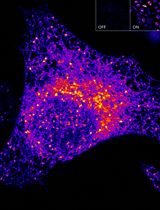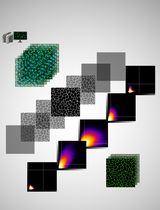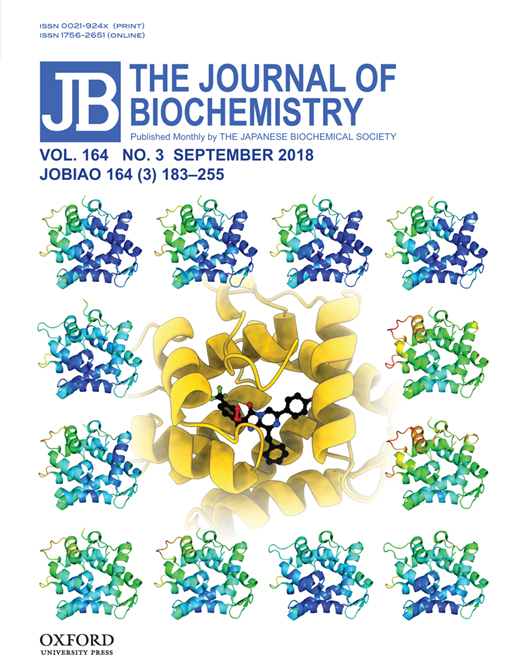- EN - English
- CN - 中文
Spatial Image Correlation Spectroscopy (ICS): A Technique for Average Size Determination of Subcellular Accumulated Structures from Fluorescence Microscopic Images
空间图像相关光谱法(ICS):一种从荧光显微图像中确定亚细胞聚集结构平均尺寸的技术
发布: 2020年05月20日第10卷第10期 DOI: 10.21769/BioProtoc.3624 浏览次数: 3930
评审: Anonymous reviewer(s)

相关实验方案

高灵敏且可调控的 ATOM 荧光生物传感器:用于检测细胞中蛋白质靶点的亚细胞定位
Harsimranjit Sekhon [...] Stewart N. Loh
2025年03月20日 1372 阅读

基于Fiji ImageJ的全自动化流程开发:批量分析共聚焦图像数据并量化蛋白共定位的Manders系数
Vikram Aditya [...] Wei Yue
2025年04月05日 1713 阅读
Abstract
Size determination of subcellular structures such as inclusion bodies (IBs) and granules from fluorescent images is important for identification and structural characterization. However, it is often time-consuming just for the comparison of the average size of the structures. Here, we introduce a high-throughput procedure to represent the average size of structures in fluorescent images using Spatial Image Correlation Spectroscopy (SICS). This procedure provides an easier comparison of bodies and granular structures such as inclusion bodies (IBs) including misfolded protein aggregation, granules containing RNA (e.g., stress granules and processing bodies).
Keywords: Protein aggregation (蛋白质聚集)Background
Inclusion bodies (IBs) are often observed in neurons from patients with neurodegenerative diseases and even in cells from healthy organisms (Ross and Poirier, 2004; Anderson and Kedersha, 2006; Kitamura et al., 2015). IB including misfolded protein aggregation is a hallmark of neurodegenerative diseases. Size determination of such IBs is important to identify and characterize the IBs. IBs and subcellular structures are usually visualized using fluorescent proteins and/or immunofluorescence because fluorescence labeling provides a desirable specificity towards the structure of interests against low signal in background (Kitamura and Kinjo, 2018). To determine the size of the subcellular structures such as IBs in fluorescent images, the radius and the area of a structure have been directly measured using image analysis software (e.g., ImageJ, Fiji, Metamorph, and so on). In this procedure, it is necessary to design a mask that accurately reflects the size of a specific structure, and it is sometimes not easy for researchers to design a mask that can properly distinguish the edge of the structure. Although the procedure using a mask is advantageous in analysis for individual size identification, it is time-consuming just for a high-throughput comparison of their average size. Accordingly, it is important to represent high-throughput determination of structure size from fluorescent image.
Autocorrelation function (ACF) is used for the analysis especially in Fluorescence Correlation Spectroscopy (FCS) and light scattering (Oasa et al., 2015; Kitamura and Kinjo, 2018; Veerapathiran and Wohland, 2018). Since the process of changing the persistence of the signal over time can be determined using ACF, average time of analyzing molecules passing through the detection volume can be determined. In this way, ACF is suitable for extracting physical quantities of correlated events. ACF can be applied to analyze not only temporally but also spatially correlated phenomena such as persistence and regularity where structure exists. Therefore, calculated spatial ACF based on the Spatial ICS principle can represent an average size parameter of the structures (Kolin and Wiseman, 2007; Kitamura et al., 2018). In this protocol, we introduce a procedure to calculate a spatial ACF and to determine the size of the structure such as IBs and intracellular bodies.
Materials and Reagents
- Glass base dish (35 mm) with #1S thickness coverglass (IWAKI, catalog number: 3971-035 )
- Murine neuroblastoma Neuro-2a cell cells (ATCC, catalog number: CLC-131 )
- Plasmid vector for green fluorescent protein (GFP)-tagged wildype Optineurin (GFP-OPTN-WT) expression in mammalian cells (pGFP-OPTN-WT) (RIKEN DNA Bank Human Resource, catalog number: RDB16707 ) (Kitamura et al., 2018)
- Dulbecco's Modified Eagle Medium (DMEM) (Sigma-Aldrich, catalog number: D5796 )
- Fetal bovine serum (FBS) (Thermo Fisher, catalog number: 12676029 )
- Penicillin-Streptomycin Solution (×100) (Fujifilm Wako Pure Chemicals, catalog number: 168-23191 )
- Opti-MEM I Reduced Serum Medium (Thermo Fisher, catalog number: 31985070 )
Equipment
- Laser scanning microscope (LSM) 510 META with a C-Aprochromat 40×/1.2 W UV-VIS-IR water immersion objective (Carl Zeiss)
- GNU Octave or MATLAB (MathWorks, Natick, MA) for calculation of spatial autocorrelation function (SACF) image
- Lipofectamine 2000 (Thermo Fisher)
Software
- Fiji or ImageJ software for image processing
- Three-dimensional non-linear curve fitting software
Here we introduce the procedure using Origin (OriginLab. Corp., Northampton, MA); however, you can use other software for non-linear 3D curve fitting (e.g., Table Curve 3D or LAB fit).
Procedure
文章信息
版权信息
© 2020 The Authors; exclusive licensee Bio-protocol LLC.
如何引用
Kitamura, A. and Kinjo, M. (2020). Spatial Image Correlation Spectroscopy (ICS): A Technique for Average Size Determination of Subcellular Accumulated Structures from Fluorescence Microscopic Images. Bio-protocol 10(10): e3624. DOI: 10.21769/BioProtoc.3624.
分类
细胞生物学 > 细胞成像 > 共聚焦显微镜
生物化学 > 蛋白质 > 荧光
您对这篇实验方法有问题吗?
在此处发布您的问题,我们将邀请本文作者来回答。同时,我们会将您的问题发布到Bio-protocol Exchange,以便寻求社区成员的帮助。
提问指南
+ 问题描述
写下详细的问题描述,包括所有有助于他人回答您问题的信息(例如实验过程、条件和相关图像等)。
Share
Bluesky
X
Copy link









